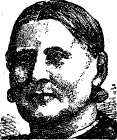Lovisa Åhrberg facts for kids
Quick facts for kids
Maria Lovisa Åhrberg
|
|
|---|---|
 |
|
| Born | 17 May 1801 |
| Died | 26 March 1881 Stockholm
|
| Occupation | Doctor, Surgeon |
| Notes | |
|
Possibly the first female doctor in Sweden.
|
|
Maria Lovisa Åhrberg (born May 17, 1801 – died March 26, 1881) was an amazing Swedish surgeon and doctor. She practiced medicine legally long before women were officially allowed to study it at universities in 1870. Lovisa Åhrberg is often seen as the first woman in Sweden with official permission to work as a doctor. This was special because she didn't have a university degree. The first woman to get a medical degree from a university was Karolina Widerström.
Contents
A Trailblazing Doctor
Lovisa Åhrberg was born in Uppsala, Sweden. Her father, Erik Årberg, worked at Uppsala University. Her mother, Britta Maria Upgren, was known as a "cunning woman." This meant she practiced traditional folk medicine. Lovisa's grandmother also helped people with folk medicine and nursing. In those days, nurses were usually helpers without formal training.
Early Life and Learning
As a child, Lovisa often went with her mother to hospitals. She also visited sick people's homes. This way, she learned a lot about medicine just by watching and helping. She never went to a formal medical school. This was because women were not allowed to study medicine at universities back then.
Moving to Stockholm
As an adult, Lovisa Åhrberg moved to Stockholm. She worked as a maid for a middle-class family. In her free time, she started helping friends from Uppsala who were sick or injured. People knew about her family's background in healing. Because her treatments worked well, more and more people heard about her. Soon, many clients in Stockholm wanted her medical help.
At first, her patients were mostly poor people. But over time, wealthier people also started to hire her. They paid her well for her services. Around 1840, she was able to stop working as a maid. She could support herself completely as a doctor.
Facing Challenges
Even though Lovisa Åhrberg was a successful doctor, she didn't have an official license. Her training was informal, not from a university. This was impossible for women at the time. Women could not study medicine at a university until 1870.
Charges and Acquittal
Lovisa Åhrberg faced a lot of opposition from male doctors. They were against a woman practicing medicine in the city. She was officially investigated for "quackery." This meant practicing medicine without proper training or a license.
However, after an examination, Lovisa Åhrberg was found to have enough medical knowledge. Her practices were not harmful. So, she was cleared of the charges. She was given permission to continue practicing medicine. This was very unusual, as it was formally banned for women. She mainly worked as a surgeon. She also used natural herbal remedies for illnesses.
On May 12, 1852, King Oscar I of Sweden gave Lovisa Åhrberg a silver medal. It was for Medborgerlig Förtjänst, which means 'Citizen Service'. This award showed that her work as a doctor was officially recognized.
Helping Others
Many people admired Lovisa Åhrberg, including the famous writer Fredrika Bremer. In her novel Hertha (1856), Bremer wrote about Åhrberg. She praised Lovisa's patience and kindness. She also mentioned how Lovisa helped many poor people.
A Doctor for Everyone
People often called Åhrberg "The wound healer doctoress" or "Maiden Åberg." This showed how unusual it was to have a female doctor then. A book from 1864–1866 described her clinic as a "poor man's clinic." This was because she treated so many people who couldn't afford much. The book also said that Lovisa's hard work affected her health. She sometimes had to rest in places like Carlsbad.
Retirement and Legacy
In 1871, Lovisa Åhrberg became blind and retired. She had saved a lot of money and lived comfortably. She passed away in Stockholm in 1881.
Only one student was known to have learned from her. This was "Doctoress Henricsson." She worked at the Serafimerlasarettet hospital. Then she opened her own practice in 1865. She was called a nurse, but the job of a trained nurse didn't exist yet. So, her job was also hard to define, just like Åhrberg's.
The year after Lovisa Åhrberg died, women were finally allowed to study medicine at universities in Sweden. This opened the door for women like Karolina Widerström to become the first female doctors with formal degrees.
See also
 In Spanish: Lovisa Åhrberg para niños
In Spanish: Lovisa Åhrberg para niños

